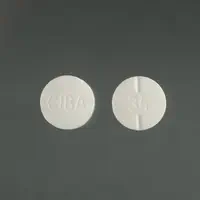DRUGS: WHAT YOU
NEED TO KNOW Booklet

Signs and Symptoms of Ritalin (Methylphenidate) Addiction

Methylphenidate is a prescription stimulant best known by the brand name Ritalin. This was the first well-known prescription handed out to young people diagnosed with unusual difficulties sitting still or focusing on tasks or studies. Though the accuracy of this diagnosis has been disputed by many authorities, the standard treatment was the prescription of methylphenidate or a similar prescription stimulant.
Methylphenidate is prescribed in many different forms:
- Immediate-release or extended-release liquid
- Chewable tablets
- Immediate-release pills and capsules
- Extended-release pills and capsules
- Transdermal patch
Methylphenidate is known by these brand names:

Courtesy of DEA.gov
- Ritalin
- Methylin
- Metadate
- Quillichew ER
- Quillivant XR
- Concerta
- Aptensio XR
- Adhansia XR
- Daytrana
- ER and XR both refer to extended-release formulas.
Why Methylphenidate Is Prescribed
In addition to being prescribed for attention disorders, it is prescribed for narcolepsy, depression, pain and cognitive disorders. It acts by stimulating the central nervous system (CNS).

Ritalin’s reputation for enabling high school and college students to cram all night for tests or write a complete term paper in a weekend has encouraged widespread abuse of this drug. As a CNS stimulant, it causes wakefulness and alertness, even if the person is not well-rested. The Substance Abuse and Mental Health Services Administration estimates that 288,000 youth aged 12 to 17 misuse a drug in this category every year and 1.6 million people aged 18 to 25 do the same.1
Physical Signs of Methylphenidate Addiction
Each of these forms of methylphenidate has abuse potential and can cause addiction. Misusing this drug means that someone uses it without a prescription, takes more than a doctor prescribed, takes it more frequently or takes it in a manner not recommended. For example, a person might dissolve a pill and inject the liquid or crush pills and snort the powder.
While recommended dosages go as high as 60 milligrams per day, some people who snort this drug consume as much as 200 mg. Intravenous users have been known to consume between 40 mg and 1000 mg.
These are the signs users might show when they become addicted to methylphenidate.
- Insomnia
- Stomachache
- Irritability
- Vomiting
- Muscle tightness
- Headache
- Loss of appetite
- Weight loss
- Increased heart rate
- Faster breathing
- Uncontrollable movement of a part of the body
- Back pain
Behavioral, Mental and Emotional Signs of Methylphenidate Addiction

When snorted, this drug produces an instant “high” similar to that of cocaine. High dosages of methylphenidate can also cause these symptoms:
- Euphoria
- Hallucinations
- Paranoia
- Delusional disorder
- Psychotic episodes
- Anger
- Depression
- Abnormal excitement2
The Long-Term Physical Damage of Methylphenidate Addiction
Dissolving and injecting tablets of Ritalin or other forms of methylphenidate can potentially be disabling or fatal as well as addictive.
Injection of this drug can also result in a condition called Ritalin lung. Methylphenidate pills produced by multiple manufacturers contain talc. When this type of pill is dissolved and injected, the talc causes an emphysema-like condition resulting from the destruction of tiny air sacs in the lungs.3
The airflow restriction can be worse than that experienced in chronic obstructive pulmonary disease. If the damage is bad enough, a lung transplant will be needed. This condition may not reverse when drug abuse ends.4
There have also been a few cases of muscular breakdown called rhabdomyolysis, a problem that can cause kidney failure and death if not treated promptly. 5
The Long-Term Emotional and Mental Damage of Methylphenidate Addiction
An analysis of many studies related to the long-term use of methylphenidate found that depression, anxiety, irritability, suicidal ideation, bipolar disorder and psychotic-like symptoms can result from long use.
Methylphenidate Overdose
While it’s rare, it is possible to fatally overdose from methylphenidate abuse. A user may also experience a dangerously high fever, irregular heartbeat, seizures and heart failure if high doses are taken.6,7
This stimulant may further cause these symptoms during an overdose:
- Restlessness
- Vomiting
- Nausea
- Blurred vision
- Uncontrollable shaking
- Muscle twitching
- Confusion
- Aggression
- Panic attacks
- Overactive reflexes
- Muscle pain
- Toxic psychosis
- Delirium
- Seizures
- Weakness
- Convulsions
- Coma
- Death
Withdrawal from Methylphenidate
It is common for those withdrawing from methylphenidate to suffer fatigue, severe depression, and interrupted sleep patterns while they clear this drug from their system.
Helping a Person Who Has Been Abusing Methylphenidate
Because it is a prescription drug and because it is so widely prescribed to children, it would be easy to assume that methylphenidate is a harmless drug. This is far from the truth. A person who is abusing this drug risks permanent damage, psychotic breaks and seizures. The best thing to do is to help a person who is abusing or addicted to this drug to find a good rehab program and learn how to enjoy life sober.
Methylphenidate or any stimulant is very hard on the body. Getting healthier and getting one’s life under one’s own control should include breaking free from methylphenidate addiction.
Sources:
-
SAMHSA. “Key Substance Use and Mental Health Indicators in the United States: Results from the 2020 National Survey on Drug Use and Health.” Substance Abuse and Mental Health, 2021. SAMHSA Publication (PDF) ↩︎
-
NIH. “Methylphenidate Abuse and Psychiatric Side Effects.” NIH, 2000. NIH Article ↩︎
-
Radiopaedia. “Ritalin lung.” Radiopaedia, 2020. Radiopaedia Article ↩︎
-
National Institutes of Health. “Successful lung transplantation for talcosis secondary to intravenous abuse of oral drug.” NIH, 2008. NIH Article ↩︎
-
NIH. “Prevalence of Rhabdomyolysis in Sympathomimetic Toxicity: a Comparison of Stimulants.” NIH, 2015. NIH Article ↩︎
-
NIH. “A fatality due to the intranasal abuse of methylphenidate (Ritalin).” NIH, 1999. NIH Article ↩︎
-
NIDA. “Prescription stimulants.” NIDA, 2018. NIDA Publication (PDF) ↩︎


